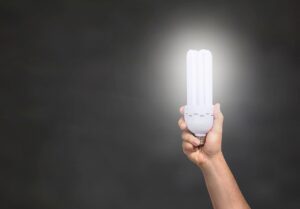August 22, 2022
By Anastazia Csegeny
—
Cooler fall temperatures are finally beginning to replace the sweltering summer heat of the past few months, but the challenge of rising energy costs remains for Canadians across the country. With inflation hitting a 40-year high, it is more important now than ever before to conserve energy both at home and at work. Here are a few things you can do to reduce your business’ energy consumption and start working towards more eco-conscious and cost-efficient business practices.
Use natural light or energy efficient lighting
Natural light is a great way to brighten up a workspace, reduce the need for electric lights, and even improve mental health and well-being. At the beginning of your workday, whether you are working remotely or in the office, take a few minutes to open your curtains and let the sunlight warm your surroundings instead of costly overhead artificial lighting. Most rooms have windows, which makes it easy to use natural light, but it can be difficult to use natural light in the areas of a building that don’t have as many windows, like hallways or foyers. For these areas, skylights can bring in significant amounts of light and reduce the need for an extra lamp.
When it isn’t possible to use natural light in a space, consider using light emitting diodes (LEDs), the most energy efficient lighting available today. Many businesses are converting from fluorescent or HID lighting to LEDs and are experiencing endless benefits. LEDs can reduce power usage by as much as 85% and reduce your carbon footprint. They also provide more instantaneous and better lighting than HID or fluorescent lights, and they can withstand the often-harsh changing temperatures of Canadian winters and summers.
Unplug or turn off devices not in use
“Phantom” or “standby” power, when electronics continue to draw power even when they are off, can account for up to 10% of your home energy use. According to Hydro One, the average Canadian home has 25+ electronic devices that use phantom power, which costs $150 each year in wasted electricity. If we consider the number of electronic devices, equipment, or machinery in an office building or factory, the wastes of phantom power become even more concerning.
Motion sensors and auto-off power bars are helpful in reducing the standby power of any unused devices or equipment. Switched outlets are also a good way for a business to turn off a group of electronics at once. It can be a hassle at the end of a workday to turn off devices one by one, but timers and group switches can alleviate that frustration and save you valuable energy.
Monitor the load on your HVAC system and check for drafts
A well-tuned and efficient HVAC system can significantly reduce your business’ energy bill and ensure a comfortable working environment for your employees. Annual maintenance, tune-ups, and repairs for central air and heating systems should be performed by a qualified HVAC contractor, but regular maintenance can be managed by the business, including cleaning filters, coils, and ducts. Take some time to learn the type and age of your HVAC system and follow the manufacturer’s recommended procedures as needed to ensure energy is not wasted. But if problems arise, call a service technician to assist you.
It is also important to check your building for any drafts, that is, small cracks or holes around window or doorframes. Windows and doors should be properly sealed with caulk to keep cool air inside during the summer and heat inside during the winter. Even with good air leakage control, try to turn off or adjust air conditioning and heat when the building is not in use, like on the weekend or during a holiday. A smart thermostat connected to a mobile phone can help you keep tabs when you are away and make sure nothing is being wasted.
Avoid peak energy times and strategize your workflow
In Ontario, the cost of energy varies according to Time-of-Use (TOU) rates since the cost of producing electricity at different times of day fluctuates depending on demand. TOU pricing uses three periods: on-peak (high cost), mid-peak (moderate cost), and off-peak (low cost). It can be a challenge to coordinate energy use with TOU rates, but the different periods ultimately give homeowners and businesses more control over their electricity bills and a leg-up on how they can actively save energy.
For businesses, it can be helpful to strategize your workflow in light of peak energy times. Though business operations are high during the daytime, the shifts of employees can be reorganized so that certain machines and devices are not used until later off-peak times when there is lower demand for energy.
Book an energy efficiency audit
All of the above tips are things you can do on your own to start saving energy for your business, but it also never hurts to ask an expert for help. Daisy Energy prides itself on helping companies identify a wide range of energy saving solutions with a No-Cost Energy Assessment. It’s not easy to juggle the day-to-day operations of a business alongside growing energy concerns. However, specialized energy efficiency audits can provide the added insight on how to strengthen the energy sustainability of your business and the next steps to take towards being more eco-conscious.




































